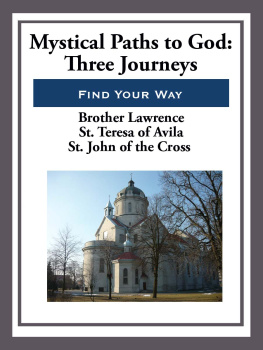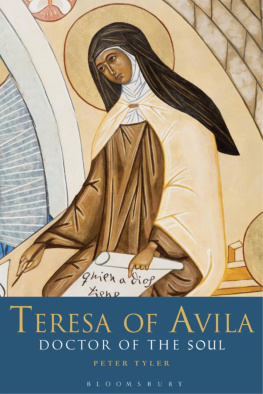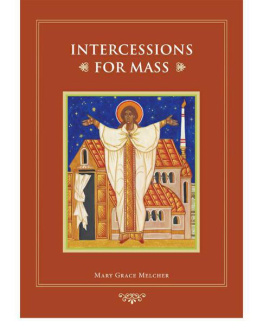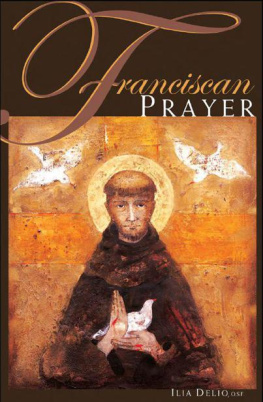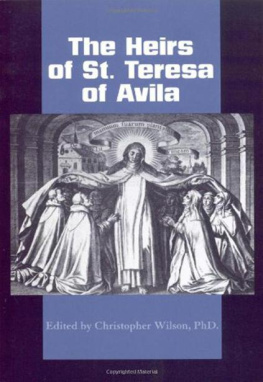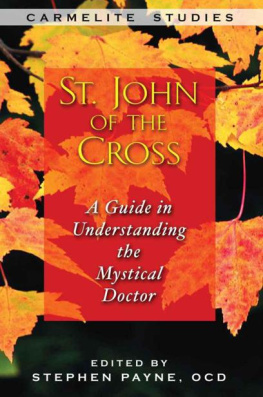BOOKS BY PETER-THOMAS ROHRBACH
Non-Fiction
JOURNEY TO CARITH
CONVERSATION WITH CHRIST
A GIRL AND HER TEENS
THE SEARCH FOR ST. THRSE
THE ART OF DYNAMIC PREACHING
Fiction
A GENTLE FURY
BOLD ENCOUNTER
Translation
THE PHOTO ALBUM OF ST. THRSE
JOURNEY TO CARITH
THE STORY OF
THE CARMELITE ORDER
PETER-THOMAS ROHRBACH, O.C.D
ICS Publications
Institute of Carmelite Studies
Washington, D.C.
First Edition
Copyright 1966 by Peter-Thomas Rohrbach
All Rights Reserved
Library of Congress Catalog Card Number 66-20942
Printed in the United States of America
Imprimi potest: Christopher Latimer, O.C.D., Provincial
Nihil obstat: Jerome Flynn, O.C.D., Censor Deputatus
Imprimatur: Patrick A. OBoyle, Archbishop of Washington
The nihil obstat and imprimatur are official declarations that a book or pamphlet is free of doctrinal or moral error. No implication is contained therein that those who have granted the nihil obstat and the imprimatur agree with the content, opinions, or statements expressed.
ICS Publications Editions (2005, 2015)
Copyright 1966, 2015 by Peter-Thomas Rohrbach
ISBN-10: 0-935216-45-6
ISBN-13: 978-0-935216-45-5
ISBN (epub): 978-1-939272-30-0
All rights reserved. No part of this book may be reproduced or transmitted in any form or by any means, electronic or mechanical, including photo-copying, recording, or by any information storage and retrieval system without prior written permission from the publisher.
Cover design by Say Yes Design
Cover images:
(Front cover) Hermits at the Fountain of Elijah (Back Cover) St. Albert Presents the Rule to the Carmelites by Pietro Lorenzetti (1280-1348); predella panel, tempera on wood; date: between 1328 and 1329; Pinacoteca Nazionale di Siena
Preface
When Journey to Carith was first published by Doubleday & Co. in 1966, it was praised for its broad scope and felicitous style. In an engaging narrative of less than 400 pages, Peter-Thomas Rohrbach had somehow managed to survey a full eight centuries of the Carmelite tradition. One reviewer even proposed the book as a new model for histories of other religious orders.
Decades have passed since the appearance of this work and important new discoveries in the study of Carmelite history have come to the fore. Unfortunately, such scholarly research is not yet readily accessible to the general public. Readers are still awaiting a new single-volume popular history of the Discalced Carmelite tradition that incorporates the latest findings. In the meantime, despite its limitations, Journey to Carith remains unsurpassed as a concise and readable overview.
Responding to numerous requests, therefore, ICS Publications has arranged with the author for this reprint edition. We have changed the subtitle to reflect the fact that the book is really about the people and events associated with the discalced branch of the Carmelite family as well as the first four centuries of the Carmelite tradition out of which St. Teresas reform grew.
Readers should be aware that the authors account of the origins of Carmel in the first chapter has been superseded. Carmelite historians now believe that our first hermit community in the wadi-es-Siah on the slopes of Mount Carmel could not have begun much before the beginning of the thirteenth century, and that figures such as Aymeric and Berthold are largely mythological. In fact, the earliest historical document concerning this original hermit community is the Rule given to them by Albert, the patriarch of Jerusalem, around the year 1209. This rule mentions a prior with the initial B, about whom nothing else is known.
Again, current studies of sixteenth-century Carmel suggest a more nuanced picture of the beginnings of the Teresian Reform. The Carmelites of Castile were in fact considered relatively observant at the time Teresa of Avila began her foundations there, and all parties shared responsibility for the painful conflicts that erupted.
For other works on Carmelite origins, readers are encouraged to consult historian Joachim Smets multivolume work, The Carmelites: A History of the Brothers of Our Lady of Mount Carmel (Darien, IL.: Carmelite Spiritual Center, 1976-85), as well as John Welchs The Carmelite Way (New York: Paulist Press, 1996).
Despite the need for some updating, Journey to Carith remains a fascinating account of one of the oldest religious families in the Christian West, with a uniquely important spiritual tradition. This book that has inspired so many in the past, we hope, will continue to fire readers with an interest in the order of Carmel.
Kieran Kavanaugh, OCD
Carith was a wadi, a small watering place, where the Lord God sent the prophet ElijahDepart from here and turn eastward, and hide yourself by the torrent of Carith, which is east of the Jordan.
(I Kings 17:3)
The medieval Carmelites, who proposed themselves as followers and imitators of Elijah, found in this one episode in the prophets life a symbol of their entire life and dedication. Playing on the phonetic similarity between Carith and the Latin word caritas (love), they envisioned the trip to Carith as a journey to love.
TABLE OF CONTENTS
This is the chronicle of a family. Granted, a family of enormous proportions, a family of long historical traditions and vast membership, embracing territories and cultures around the worldbut for all of that, a family. It is in this light that any religious order must be seen: not so much as an institution or an apostolic mechanism, but as a divinely oriented grouping of people into an association of mutual love and common objectives. A religious order is the family of God in the truest sense of the term, with its own origin, its own history, its own spirit, its own people.
This is the story of the Carmelites, one family in the Church of God, like other religious families in many respects, but unique and individual as every family must be. Carmelas the Carmelite order is calledoriginated in the Eastern world of Palestine, and found its flourishing in western Europe. It became a part of the popular mendicant movement of the thirteenth century. It succumbed to the nadir of the religious orders of the fourteenth and fifteenth centuries. It was resuscitated by the sixteenth-century reformers, St. John of the Cross and St. Teresa of vila, who articulated and restated its deep contemplative and mystical tradition. Then it spread to the New World and to the Indies and the Orient. It was devastated by the upheavals following the French Revolution, and then regrouped itself for a strong continuance into the twentieth century. Like all families, Carmel has had its bright moments and its dark moments, its days of great prosperity and purpose and its days when it seemed to be confused and stumbling; it has known strife and disagreement from within, persecution and misunderstanding from without. But it survivedbecause it had that basic human dynamism that all families have, and because it was divinely inspired and divinely protected.
This chronicle, however, must not be merely a report of historical movements and grand epochs; it must be a story of people. Matthew Arnold said that history is the essence of innumerable biographies. And so this must be: an honest account of the people of Carmel, products of their own lineage, but involved in the instant historical moment, similar fiom country to country and epoch to epoch, but different and individual as only people can be.



